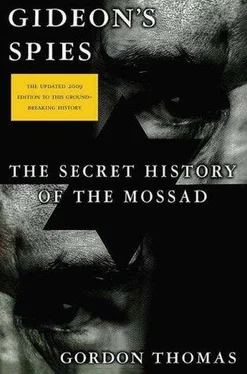Gordon Thomas - Gideon's Spies
Здесь есть возможность читать онлайн «Gordon Thomas - Gideon's Spies» весь текст электронной книги совершенно бесплатно (целиком полную версию без сокращений). В некоторых случаях можно слушать аудио, скачать через торрент в формате fb2 и присутствует краткое содержание. Город: New York, Год выпуска: 2009, ISBN: 2009, Издательство: Thomas Dunne Books, Жанр: История, на английском языке. Описание произведения, (предисловие) а так же отзывы посетителей доступны на портале библиотеки ЛибКат.
- Название:Gideon's Spies
- Автор:
- Издательство:Thomas Dunne Books
- Жанр:
- Год:2009
- Город:New York
- ISBN:978-0-312-53901-6
- Рейтинг книги:4 / 5. Голосов: 1
-
Избранное:Добавить в избранное
- Отзывы:
-
Ваша оценка:
- 80
- 1
- 2
- 3
- 4
- 5
Gideon's Spies: краткое содержание, описание и аннотация
Предлагаем к чтению аннотацию, описание, краткое содержание или предисловие (зависит от того, что написал сам автор книги «Gideon's Spies»). Если вы не нашли необходимую информацию о книге — напишите в комментариях, мы постараемся отыскать её.
Gideon’s Spies
Gideon's Spies — читать онлайн бесплатно полную книгу (весь текст) целиком
Ниже представлен текст книги, разбитый по страницам. Система сохранения места последней прочитанной страницы, позволяет с удобством читать онлайн бесплатно книгу «Gideon's Spies», без необходимости каждый раз заново искать на чём Вы остановились. Поставьте закладку, и сможете в любой момент перейти на страницу, на которой закончили чтение.
Интервал:
Закладка:
He put down blindly refusing to follow the rule book as stemming from his Galilean background: “We are a stubborn lot.” He had been born in King Herod’s favorite city, Tiberias, close to the shore of the Sea of Galilee, and spent most of his early life on a kibbutz. Long ago all traces of the region’s flat accent had been smoothed away by his mother, an elocution teacher. She had also instilled her son’s sense of independence, his refusal to tolerate fools, and a barely concealed contempt for city dwellers. Most important of all, she had encouraged his analytical skills and ability to think laterally.
In his long career he had used those qualities to discover an enemy’s intention. Often action could not wait for certainty, and motive and deception had been at the center of his work. At times his critics in the Israeli intelligence community had been concerned at what they saw as his imaginative leaps. He had one answer for them all: Read the case file on the stolen MiG.
On this March morning in 1997, as he continued to drive out of Tel Aviv, Meir Amit was officially on the retired list. But no one in Israeli intelligence believed that was the case; his vast knowledge was too valuable to be put in cold storage.
The previous day Meir Amit had returned from Ho Chi Minh City, where he had visited former Vietcong intelligence officers. They had swapped experiences and had found common ground over besting superior opposition: the Vietnamese against the Americans, Israel fighting the Arabs. Meir Amit had made other trips to places where his secret maneuvers had once created havoc: Amman, Cairo, Moscow. No one dared to question the purpose of these visits, just as during his five momentous years as director general of Mossad—1963–68—no one had mounted a successful challenge over his sources or methods.
In that period he had turned humint, human intelligence gathering, into an art form. No other intelligence agency had been able to match his agents on the ground in collecting information. He had placed spies in ever greater numbers in every Arab country, across Europe, down into South America, throughout Africa, and in the United States. His katsas had penetrated the Jordanian Mukabarat, the best of the Arab intelligence services, and Syrian military intelligence, the most cruel. They were men of cool nerve and steel resolve that no novelist would have dared to invent.
Soon after he became director general, Meir Amit circulated within the service a memo stolen by an agent from Yasser Arafat’s office:
“Mossad has a dossier on each of us. They know our names and addresses. We know there are two photographs with each of our files. One is a copy of how we look without a kaffiyeh and the other wearing one. So the Mossad have no difficulty tracking us down with or without our headdresses.”
To create further fear, Meir Amit had recruited an unprecedented number of Arab informers. He worked on the principle that by the law of averages he would discover a sufficient number who would be useful. Bribed Arabs had betrayed PLO gunmen and revealed their arms caches, safe houses, and travel arrangements. For each terrorist killed by Mossad, Meir Amit paid an informer a bonus of one U.S. dollar.
In the run-up to the Six Day War in 1967, there was either a Mossad katsa or an informer inside every Egyptian air base and military headquarters. There were no fewer than three in the General High Command headquarters in Cairo, staff officers who had been persuaded by Meir Amit. How he had done so had remained his closely guarded secret : “There are some matters best left that way.”
To each informer and agent in place he had given the same instruction : as well as “the big picture,” he wanted “the small details. How far did a pilot have to walk from his barracks to the mess for his meals? How long was a staff officer held up in the notorious Cairo traffic jam? Did a key planner have a mistress?” Only he fully understood how such disparate matters would be used.
One katsa had managed to get himself a job as a waiter in the officers’ mess in a frontline fighter base. Every week he provided details of aircraft readiness and the lifestyle of pilots and technicians. Their drinking habits and sexual pleasures were among the information secretly radioed to Tel Aviv.
Mossad’s newly created Department of Psychological Warfare, Loh Amma Psichologit (LAP), worked around the clock preparing files on Egyptian fliers, ground crew, and staff officers: their flying skills, whether they had achieved their rank through ability or influence, who had a drink problem, frequented a brothel, had a predilection for boys.
Well into the night, Meir Amit pored over the files, looking for weaknesses, for men who could be blackmailed into working for him. “It was not a pleasant task but intelligence is often a dirty business.”
Egyptian families of servicemen began to receive anonymous letters posted in Cairo giving explicit details of their loved one’s behavior. Informers reported back to Tel Aviv details of family rows that led to aircrew going on sick leave. Staff officers had anonymous phone calls giving information about a colleague’s private life. A teacher at school was called by a sympathetic-sounding woman to be told that the only reason a pupil was doing badly was because her father, a senior officer, had a secret male lover; the call led to the officer shooting himself. This relentless campaign caused considerable dissension within the Egyptian military and brought great satisfaction to Meir Amit.
By early 1967, it became clear from all the evidence his Egyptian network was producing that the country’s leader, Gamal Abdel Nasser, was preparing for war against Israel. More informers were recruited by fair means or foul, helping Mossad to know as much about the Egyptian air force and its military command as did Cairo.
By early May 1967 he was able to give Israel’s air force commanders the precise time of day they should launch a knockout strike against the Egyptian air bases. Mossad’s analysts had produced a remarkable blueprint of life on all Egyptian air bases.
Between 7:30 A.M. and 7:45 A.M. airfield radar units were at their most vulnerable. In those fifteen minutes the outgoing night staff were tired after their long shift, while their incoming replacements were not yet fully alert, and were often late in taking over due to slow service in the mess halls. Pilots breakfasted between 7:15 A.M. and 7:45 A.M. Afterward they usually walked back to their barracks to collect their flying gear. The average journey took ten minutes. Most fliers spent a further few minutes in the toilets before going to the flight lines. They arrived there around 8:00 A.M., the official start to the day. By then ground crew had begun to roll out aircraft from their hangars to be fueled and armed. For the next fifteen minutes the flight lines were crammed with fuel trucks and ammunition trucks.
A similar detailed itinerary was prepared for the movements of staff officers in the Cairo High Command. The average officer took thirty minutes to drive to work from his house in one of the suburbs. Strategic planners were often not at their desks before 8:15 A.M. They usually spent a further ten minutes settling in, sipping coffee, and gossiping with colleagues. The average staff officer did not properly start studying overnight signals traffic from the fighter bases until close to 8:30 A.M.
Meir Amit told the Israeli air force commander that the time their aircraft must be over their targets should be between 8:00 A.M. and 8:30 A.M. In those thirty minutes they would be able to pulverize enemy bases, knowing that the Cairo High Command would be without many of its key personnel to direct the fight back.
On June 5, 1967, Israel’s air force struck at precisely 8:01 A.M. with deadly effect, sweeping in low over the Sinai to bomb and strafe at will. In moments the sky turned reddish black with the flames from burning fuel trucks and exploding ammunition and aircraft.
Читать дальшеИнтервал:
Закладка:
Похожие книги на «Gideon's Spies»
Представляем Вашему вниманию похожие книги на «Gideon's Spies» списком для выбора. Мы отобрали схожую по названию и смыслу литературу в надежде предоставить читателям больше вариантов отыскать новые, интересные, ещё непрочитанные произведения.
Обсуждение, отзывы о книге «Gideon's Spies» и просто собственные мнения читателей. Оставьте ваши комментарии, напишите, что Вы думаете о произведении, его смысле или главных героях. Укажите что конкретно понравилось, а что нет, и почему Вы так считаете.












